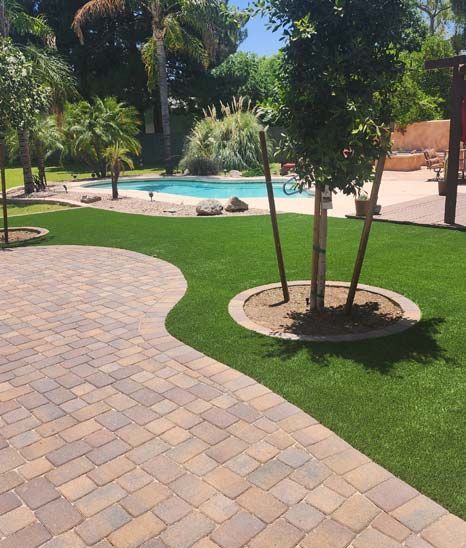How to Create a Landscape Design Plan: A Step-by-Step Guide
Creating a comprehensive landscape design plan is the first step toward transforming your outdoor space into a personal oasis. Whether you're dreaming of a serene garden to unwind, a lively area to entertain guests, or a functional space for family activities, a well-conceived design plan can turn those dreams into reality. This step-by-step guide, brought to you by Blossom & Oak Landscaping, will walk you through creating a landscape design plan, from understanding your space to implementing and maintaining your vision.
The importance of a landscape design plan cannot be overstated. It serves as a roadmap for transforming your outdoor area into a cohesive, aesthetically pleasing, and functional space. By following a structured approach, you can ensure that your landscaping project aligns with your vision, budget, and the environmental conditions of your site.
Understanding Your Space
The first step in creating a landscape design plan is to assess your current landscape thoroughly. This means taking note of the soil type, sun exposure, prevailing winds, and existing vegetation. Understanding these elements is crucial as they will influence your design choices and plant selection.
Identifying your needs and wants is equally important. Consider how you intend to use your outdoor space: Do you need a play area for children, or are you looking for a quiet spot to relax? Maybe you're interested in a vegetable garden or a sophisticated space for outdoor entertaining. Balancing these practical needs with your aesthetic preferences is key to creating a landscape that is both beautiful and functional.
Gathering Inspiration
The planning stage is an exciting part of the process where research and inspiration come into play. Look for design ideas in landscaping books, magazines, and online platforms such as Pinterest. Pay attention to garden styles that appeal to you, as well as color schemes, plant combinations, and hardscaping materials.
Creating a vision board can help organize and visualize your ideas. Compile images, fabric swatches, paint chips, and anything else that inspires you. This collage will serve as a reference point for your design and help communicate your vision to others involved in the project, ensuring that everyone is working toward the same goal.
Planning Your Design
Drawing a base map of your property is your next step. This should include the dimensions of your lot, the position of your house, and any existing features such as trees, paths, and utility lines. Accurate measurements are vital for creating a realistic and workable design.
Zoning your space involves dividing it into functional areas based on your needs and desires. Consider creating distinct zones for dining, relaxation, play, and gardening. This approach not only maximizes the usability of your outdoor space but also simplifies the design process by allowing you to focus on one section at a time.
Choosing Your Elements
Selecting the right plants is crucial for creating a landscape that thrives. Choose species that are well-suited to your soil type, sun exposure, and climate zone. Also, consider the mature size of plants to avoid overcrowding and ensure that your garden remains manageable and aesthetically pleasing over time.
Incorporating hardscaping elements such as paths, walls, and patios can add structure and interest to your garden. These features should complement the softscape (plants) and enhance the overall design. Consider the materials' textures and colors and how they fit into your desired aesthetic and functional needs.
Finalizing Your Design Plan
With your ideas and elements in place, it's time to create a conceptual design. This step involves translating your vision and sketches into a cohesive design that integrates all your chosen elements. This conceptual plan will guide the detailed planning phase, where specifics such as plant species, material types, and construction details are finalized.
Detailing your plan is where your design comes to life. Specify the types of plants, their quantities, and their locations. Also, detail the materials for your hardscaping elements and any special features like water fixtures or lighting. A detailed plan ensures that your landscape project is executed smoothly and according to your vision.
Implementation Tips
Implementing your landscape design can be a significant undertaking. Consider a phased approach, tackling one zone at a time. This method helps manage both the budget and workload, making the project more manageable and less overwhelming.
Deciding between professional help and DIY is crucial at this stage. Some aspects of landscaping, such as hardscape construction, may require professional skills and equipment. However, planting and other softscaping tasks can be enjoyable DIY projects. Assess your skills, time, and budget to make the best choice for your situation.
Maintenance Planning
Creating a maintenance schedule is essential for the longevity of your landscape. Regular tasks such as pruning, watering, and weeding will keep your garden looking its best. Consider the maintenance requirements of your chosen plants and features when planning your landscape to ensure that you can keep up with the necessary care.
Incorporating sustainable practices into your landscape design can minimize maintenance needs and environmental impact. Techniques such as mulching, composting, and using native plants can create a garden that is not only beautiful but also eco-friendly and easy to maintain.
Designing a landscape is a creative and rewarding process that enhances the beauty and functionality of your outdoor space. By following this step-by-step guide, you can create a landscape design plan that reflects your personal style and meets your needs. Remember, landscape design is an art as much as it is a science, and patience and flexibility are key to achieving your dream garden.
If you're looking for professional assistance in creating your landscape design plan, Blossom & Oak Landscaping is here to help. Our team of experienced designers and landscapers can provide the expertise and support you need to bring your vision to life. Contact us today to start your landscaping journey.


